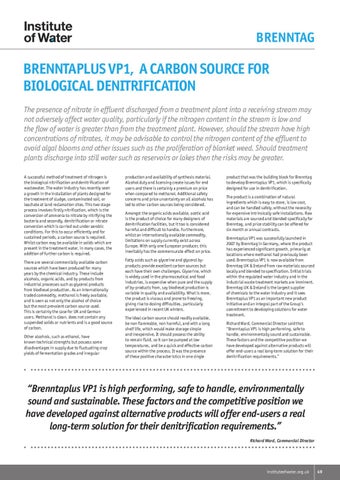h
BRENNTAG
Brenntaplus VP1, a carbon source for biological denitrification The presence of nitrate in effluent discharged from a treatment plant into a receiving stream may not adversely affect water quality, particularly if the nitrogen content in the stream is low and the flow of water is greater than from the treatment plant. However, should the stream have high concentrations of nitrates, it may be advisable to control the nitrogen content of the effluent to avoid algal blooms and other issues such as the proliferation of blanket weed. Should treatment plants discharge into still water such as reservoirs or lakes then the risks may be greater. A successful method of treatment of nitrogen is the biological nitrification and denitrification of wastewater. The water industry has recently seen a growth in the installation of plants designed for the treatment of sludge, contaminated soil, or leachate at land reclamation sites. This two stage process involves firstly nitrification, which is the conversion of ammonia to nitrate by nitrifying the bacteria and secondly, denitrification or nitrate conversion which is carried out under aerobic conditions. For this to occur efficiently and for sustained periods, a carbon source is required. Whilst carbon may be available in solids which are present in the treatment water, in many cases, the addition of further carbon is required.
production and availability of synthesis material. Alcohol duty and licensing create issues for end users and there is certainly a premium on price when compared to methanol. Additional safety concerns and price uncertainty on all alcohols has led to other carbon sources being considered.
There are several commercially available carbon sources which have been produced for many years by the chemical industry. These include alcohols, organic acids, and by products from industrial processes such as glycerol products from biodiesel production. As an internationally traded commodity, methanol is freely available, and is seen as not only the alcohol of choice but the most prevalent carbon source used. This is certainly the case for UK and German users. Methanol is clean, does not contain any suspended solids or nutrients and is a good source of carbon.
Fatty acids such as glycerine and glycerol byproducts provide excellent carbon sources but each have their own challenges. Glycerine, which is widely used in the pharmaceutical and food industries, is expensive when pure and the supply of by-products from, say biodiesel production is variable in quality and availability. What is more, the product is viscous and prone to freezing, giving rise to dosing difficulties, particularly experienced in recent UK winters.
Other alcohols, such as ethanol, have known technical strengths but possess some disadvantages in supply due to fluctuating crop yields of fermentation grades and irregular
Amongst the organic acids available, acetic acid is the product of choice for many designers of denitrification facilities, but it too is considered harmful and difficult to handle. Furthermore, whilst an internationally available commodity, limitations on supply currently exist across Europe. With only one European producer, this inevitably has the commensurate effect on price.
The ideal carbon source should readily available, be non flammable, non harmful, and with a long shelf life, which would make storage simple and inexpensive. It should possess the ability to remain fluid, so it can be pumped at low temperatures, and be a quick and effective carbon source within the process. It was the presence of these positive characteristics in one single
product that was the building block for Brenntag to develop Brenntaplus VP1, which is specifically designed for use in denitrification. The product is a combination of natural ingredients which is easy to store, is low cost, and can be handled safely, without the necessity for expensive intrinsically safe installations. Raw materials are sourced and blended specifically for Brenntag, and price stability can be offered for six month or annual contracts. Brenntaplus VP1 was successfully launched in 2007 by Brenntag in Germany, where the product has experienced significant growth, primarily at locations where methanol had previously been used. Brenntaplus VP1 is now available from Brenntag UK & Ireland from raw materials sourced locally and blended to specification. Initial trials within the regulated water industry and in the industrial waste treatment markets are imminent. Brenntag UK & Ireland is the largest supplier of chemicals to the water industry and it sees Brenntaplus VP1 as an important new product initiative and an integral part of the Group’s commitment to developing solutions for water treatment. Richard Ward, Commercial Director said that “Brenntaplus VP1 is high performing, safe to handle, environmentally sound and sustainable. These factors and the competitive position we have developed against alternative products will offer end-users a real long-term solution for their denitrification requirements.”
“Brenntaplus VP1 is high performing, safe to handle, environmentally sound and sustainable. These factors and the competitive position we have developed against alternative products will offer end-users a real long-term solution for their denitrification requirements.” Richard Ward, Commercial Director
instituteofwater.org.uk IOW 170.indd 49
49 1/6/11 08:57:05
